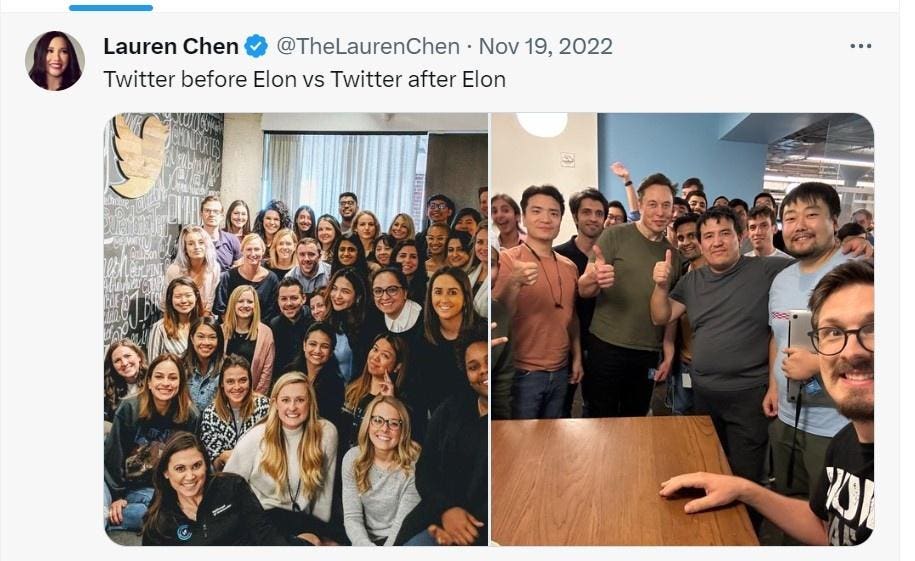In November 2022, when Elon Musk tweeted a picture of his newly formed and significantly reduced engineering team that went quicky viral, no one could have anticipated how prophetic this picture would soon become. Especially for women in the tech industry. The picture tweeted at 1.30am, timed with striking intent, and to many of us it felt hard not to see a visual adage to the tech industry’s long fought bro culture. A step back to the original ‘go hard or go home’ trope of Silicone Valley, where careers were made sleeping in the office and employees survived on energy drinks and a 5-year stock dream.
The layoffs at X (formerly Twitter) came at the beginning of what has been a slew of layoffs across the Tech industry. So far in 2023, there have been 1,532 company layoffs, with 350,961 people impacted, averaging 1,376 people per day. The job losses have skewed unfavorably towards women. Per data by Axios, it is estimated that 45% of the tech employees laid off between October 2022 and June 2023 were women. While seemingly a fair number, not when you consider that women make up only 27% of the tech workforce to begin with. These numbers are in stark contrast with an industry known for a soapbox approach to demonstrating its commitment to recruiting and retaining women, and a huge public focus on increasing diversity in the ranks over the last number of years.
A Short Lived Period of Balance?
In the 2 years leading up to the onset of layoffs we saw a mass bubble in hiring via salary inflation, increased PTO, remote working policies and the promise of an environment where you can bring your true self to work, a new genesis of openness between the personal and professional. These changes appealed to many but proved to be particularly beneficial for those historically sidelined by traditional policies. The offer of flexibility and understanding above all else, proved a strong allure. For so many employees and especially women, this new world of work seemed almost too good to be true. Until it was.
Fast-forward less than a year and the tech industry has entered a stage of large-scale recalibration, one of realignment to a pre pandemic world of realistic growth projections and less hype hiring. Data analyzing the factors that led to headcount reduction decisions were, first in, first out, remote working preferences, and focus on business groups such as HR, recruiting, operations and sales. The reality is the axe came predominantly for areas that tend to have higher numbers of female headcount and supported by policies that were often used to attract women in the first place. From a business-and-investors standpoint, this market correction is said to be long overdue. But is diversity going to be the largest cost of all? The last 3 years saw a pivotal shift away from the fast rising hustle culture of tech which pre 2020 was at peak point of infiltration across all corners of the business world. At the cornerstone of these policies is an idea of flexibility and although that’s an appeal to all genders and generations, it was galvanizing for those balancing commitments of work and family and acting as primary caregivers, predominantly women. Meta Chief Diversity Officer Maxine Williams quoted in the Washington Post in 2022, that candidates in the United States who accepted remote job offers were more likely to come from underrepresented racial groups; globally, and they were more likely to be women.
Big Tech CEO’s Speak Out
So what now? Although the Elon Musk iron-fisted ultimatum that a job at X means “long hours at high intensity” is an extreme, there has been a shift in the paramaters of flexibility. Several CEOs, including Marc Benioff Salesforce, Apple’s Tim Cook, Amazon’s Andy Jassy and Disney’s Bob Igor have taken a hard public stance on return to office, allowing refined hybrid options. For some even against public protests and open letters by staff, these tech giants appear unfazed and enthusiastic to persevere, with Amazon leadership recently telling fortune ‘There’s more energy, collaboration, and connections happening.’ What is less clear is whose energy and with whom? There is no denying the benefits of in person collaboration and a balance of hybrid is a clear winner in the quest for balance. Yet it is important to retain a focus on individual circumstances and a continued level of flexibility that does not discriminate or revert to the relentless work culture of old marooned by groupthink. It is especially ironic by recent news reports of top executives at Boeing, who have opted to jet back and forth to company HQ and opened offices closer to their homes. rather than relocate. They are not alone. Research by McKinsey has revealed they are not alone. Many high-earning mid-to-senior-level employees are resisting RTO. Yet a deviance from practice what you preach can only undermine culture and perpetuate bias. For women who find themselves back in the active labor market and those who survived the recent layoff wave it is a timely moment to reflect on priorities and from a leadership and industry perspective there needs to be a open discussion around the impacts to DE&I and talent strategy.
So What Now For Inclusion?
So the question needs to be asked, do we want to revert to an industry built by bros? We know that with the emergence of generative AI tech is at the cusp of another renaissance, with women underrepresented at 22% of current workforce. Yet diversity of thinking and lived experience is more important than ever before. In fact it is essential. We cannot build a better future with the bones of an industry that openly admits preexisting bias. The layoffs are undoubtedly a lesson in capitalism and a wakeup call in realism but they have not stopped the war on talent. Folks are bouncing back quickly, with 90% of those impacted staying in the technology industry—and more than 40% heading to smaller companies and start-ups. The catalyst? More flexibility and more challenging, innovative, interesting and purposeful work. For many back in the active labor market and those who survived the wave, the concept of a highly successful career and balance although is still non negotiable. To ignore this is a precarious approach from an industry that counts people as its most tangible asset and has said time and time again diversity is imperative to success. Industry headwinds will always create change. However, now more than ever before, steps must be taken to ensure women are pivotal in creating the change, not the price of it.
Read the full article here










